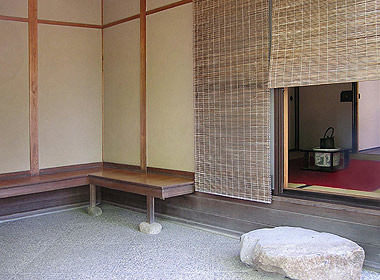|
||
 |
||
1 A waiting and resting shelter. Typically a rustic structure with a pent roof, three walls and an open front where guests rest while waiting their turn to be called to the tea house *chashitsu 茶室 to participate in a tea ceremony. It is also used to relax during intervals between tea ceremonies. There may be a bamboo latticed window in one wall and a sand toilet *sunasetchin 砂雪隠, nearby. If the shelter is located in the outer garden sotoroji 外露地, it may be called sotomachiai 外待合, hakamatsuke 袴付 or *yoritsuki 寄付. If it is located in the inner garden *uchiroji 内露地, it may be called a *koshikake machiai 腰掛待合, uchimachiai 内待合, or nakadachi koshikake 中立腰掛. Occasionally the waiting place in the inner garden is called koshikake and the one in the outer garden, machiai. Some machiai are square, doukoshikake 堂腰掛, but the usual type is the manekiyane 招き屋根 style in which one side of the roof is shorter than the other. When the tea room is made of thatched straw kaya 茅, the roof of the machiai is often tiled. The front is open and a bench is provided for the waiting guests. The bench often has a straw mat kure-ita 槫板, and wooden planks placed lengthwise on the bench. Bamboo blinds are hung to indicate the positions of the honored guest, companions, and lowest ranking participants called the last guard. A stepping stone *fumi-ishi 踏石, is placed in front of the bench, and a large stone called kinin zaseki 貴人座席 is also utilized as a trump stone *yaku-ishi 役石. Often the side wall facing the inner tea garden has a latticed window *shitajimado 下地窓, to allow the guests to view the garden. The walls usually have paper *minatogami 湊紙, pasted on the lower portions. Although most machiai are independent structures within the tea garden, several are part of other buildings. For instance: among sub-temples at Daitokuji 大徳寺, the machiai of the Teigyokuken 庭玉軒 at Shinjuan 真珠庵 is part of the hallway of the *shoin 書院; the machiai at Mittan-no-seki 密庵席 of the Ryuukouin 龍光院 is attached to the side of the main hall, and the machiai of the Kan'in-no-seki 関隠席 at Jukouin 聚光院 is built on the outside of the tea room itself. Although these machiai are really no more than covered benches, most independent machiai are quite small, often no more than one and a half *tatami 畳 size. A few, however, such as the machiai at Katsurarikyuu 桂離宮, are large, more like pavilions than small shelters.
2 An abbreviation for machiai jaya 待合茶屋. An Edo period establishment euphemistically known as a teahouse, chaya 茶屋, where guests were provided with refreshments and entertainment while waiting for performances or intimate assignations.
| 1) |
 |
(C)2001 Japanese Architecture and Art Net Users System. No reproduction or republication without written permission.
掲載のテキスト・写真・イラストなど、全てのコンテンツの無断複製・転載を禁じます。

